If Rifting Continues the Continent Will Remain Intact
Content:
- Introduction to continental rifting.
- Present active continental rifts.
- Some better known past rifts.
- Extensional accommodation mechanisms.
- Rift-related igneous activity.
- Rift basin sedimentation.
- Thermal and uplift history.
- Exercise .
- Map pattern evolution and models of continental rifting.
Introduction to continental rifting
Intro comment : Ocean basins, and the underlying oceanic crust, are often bordered by continental rocks. Also consider the mental exercise of reversing seafloor spreading - it brings the continents back together. For example, running seafloor spreading backward for the North Atlantic brings the west coast of northern Africa back to joint with the east coast of North America. This would suggest the continents come apart to make new oceanic basins. In this section we will study that process of continental 'pulling apart' - rifting. If it continues the continents can only be stretched so thin, and seafloor spreading processes take over and an oceanic basin is born. This transition is known as "rift to drift". The rifting can also be insufficient to trigger seafloor spreading processes, and instead forms a rift basin or basins within continental crust. Continental rifts are locations of continental crustal extension/divergence, crustal thinning, sedimentary basin formation, and often thermal and igneous activity. They show a complex and diverse set of patterns, sometimes concentrated, sometimes more diffuse, and localized rifting can occur in what may initially seem unlikely positions - on top of convergent mountain belts for example. So we need to look at continental rifting broadly.
Suggested reading: Rift Basin Architecture and Evolution by Roy W. Schlische & Martha Oliver Withjack at http://www.ldeo.columbia.edu/~polsen/nbcp/breakupintro.html.
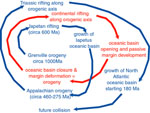 Wilson cycle concept.
Wilson cycle concept.
The basic idea in the Wilson cycle is that continental rifting tends to occur along old orogenic axes, so that these become the edges of rifted continental fragments flanking an oceanic basin that is opening. A classic case example is the Appalachian orogen (see adjacent diagram). In another example, the North Atlantic rifting also followed the path of the orogenic axis of the Norwegian and Greenland Caledonides. The basic idea is as follows. As oceanic crust gets older and colder, subduction likely starts and the ocean basin closes, with the bounding continents eventually colliding to form a new mountain belt. The old orogens are preferential weakness zones, prone to reactivation during the next rifting episode. It is basically a cycle of oceanic basin opening and closing. There are certainly examples where the Wilson cycle is not followed faithfully - it is much more of a schema. Continental rifting is a convenient starting point (but not a simple one) for the Wilson Cycle.
Long term fates of continental rifts?
- ocean basin growth and burial to form the foundation of continental passive margins:
- the implication is that old rift basin structures underlie passive continental margins such as the east coast of North and South America. Triassic grabens seen along the U.S. east coast (described below) are exposed examples of such rifts.
- aulocogens (failed rift arms).
- interior rift basin (prone to reactivation of multiple types).
Some examples of presently active continental rifts
East African Rift zone (EAR):
- USGS site on the EAR.
- rift basins and lakes, volcanics, domes
- .

- View of part of the EAR rift zone in Kenya. The image is from NASA's Visible Earth site - http://visibleearth.nasa.gov/view.php?id=77566 . In this view the fault pattern is particularly evident as the distinct linear topographic scarps. In which direction is extension occurring here? What do you thing is the age of the volcanism versus the faulting and what is your evidence? The green, vegetated area in the lower right is about 17 km long.
Rio Grande Rift (E side of Colorado Plateau) :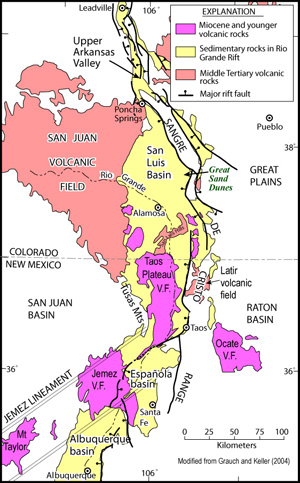
- Image to right is a USGS simplified geologic map of the Rio Grande rift. Note that while the rift is better known in New Mexico, it extends well up into Colorado. Note also the associated volcanic rocks including the "super volcano" that forms the Jemez caldera. Image source: http://crustal.cr.usgs.gov/projects/rgb/SanLuisBasin/index.html
- USGS site on the geophysics of Rio Grande Rift.
- New Mexico Geologic Survey brief summary of the history of the rift by Manley (1984).
- The Rio Grande Rift could be considered as part of the larger Basin and Range province on the other side of the Colorado Plateau, which is an area of North American crust with distinctive properties, some of which likely contributed to its being sheltered from Basin And range rifting.
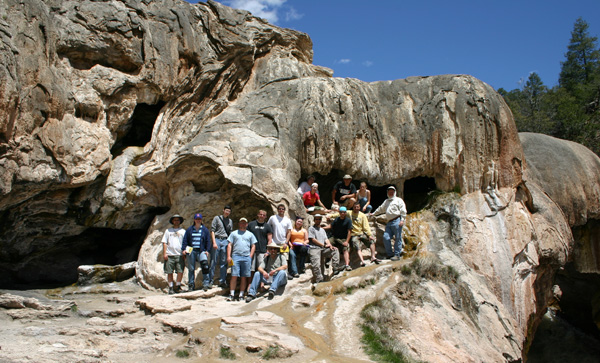
Modern hot springs deposits (calcium carbonate) along a fault on the flanks of the Jemez caldera taken from on the 2005 UNO field trip to the New Mexico Rift. Elevated geothermal gradients, and magma chambers and recent intrusions all serve to increase the heat flow of the thinned crust leading to such hydrothermal activity. For this reason rift zones can have hydrothermal related mineralization and be ore exploration targets.

Same field trip, same group as above, but in the recesses of a lava tube from a recent basalt flow from the Mal Pais area of New Mexico.
Death Valley:
- Satellite photo (false color image) from NASA's Visible Earth.
- More info on image from NASA's Visible Earth.
- More info on rift from USGS.
- also a presently active part of the Basin and Range province.
Lake Baikal Russia:
- USGS site.
- Satellite photo from NASA Visible Earth. More information at Visible Earth.
- somehow related to India-Asia collision?
Salton trough, California (transtensive):
-
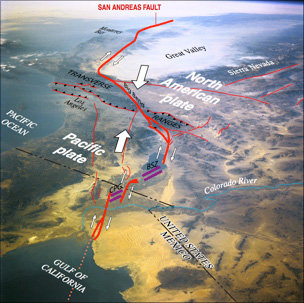
- Image from USGS site: http://earthquake.usgs.gov/regional/nca/research/salton/
Dead Sea rift (transtensive):
-
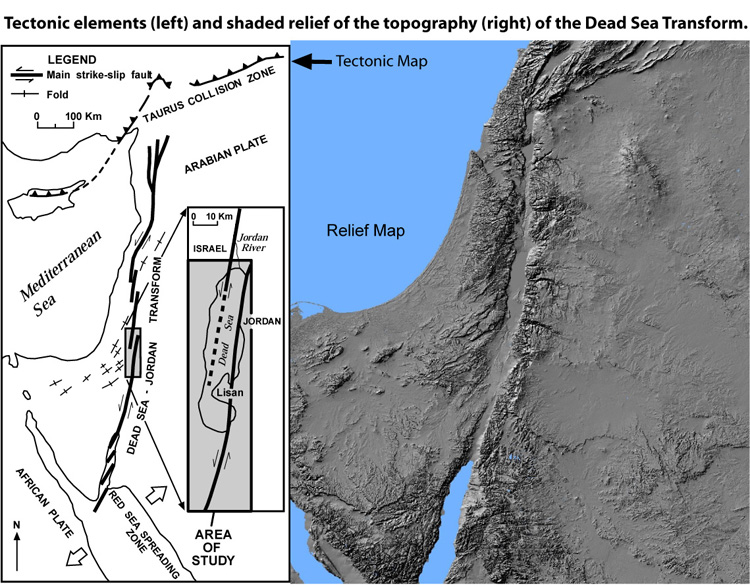
- Image from USGS site: http://woodshole.er.usgs.gov/project-pages/dead_sea/tectonic.html .

Some better known past continental rifts
Triassic grabens along U.S. east coast.
- Formed during the rifting of Africa and North America leading to the formation of the North Atlantic Oceanic basin.
- Two well known exposed rift basins: the Connecticut River Valley and the Newark Basin.
- Others are hidden beneath the Coastal Plain passive margin sediments, but have been drilled into.
- Border faults of these basins pose some seismic risk, especially the Ramapo fault in lower New York state (just up the river from NYC).
- Cross sections to right show a model for the evolution of a major basin centered on New Jersey. Image and additional information source: http://3dparks.wr.usgs.gov/nyc/mesozoic/mesozoicbasins.htm
- Note the faults and classic half-graben geometry, with a major curved (listric) fault on one side, and an overall wedge shape of the basin fill (yellow color here).
- CAMP = Central Atlantic Magmatic Province: this is one of the larger LIP provinces, and is thought to have contributed to the break up of Pangea that the Triassic grabens are part of. A short description of LIPs in general featuring CAMP can be found at http://www.ldeo.columbia.edu/~polsen/nbcp/lipmc.html .
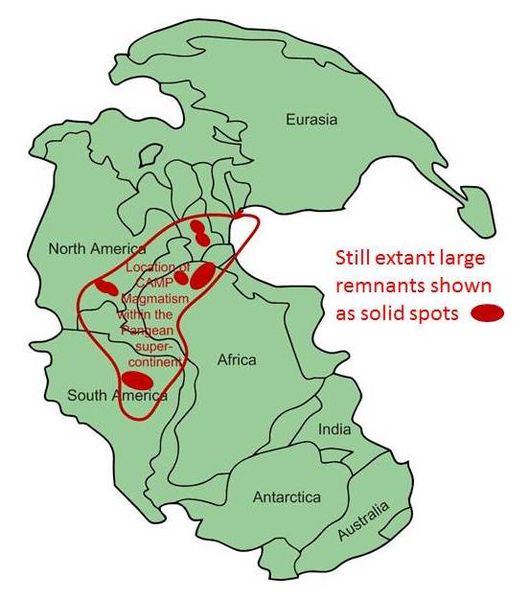
Image showing the footprint of the LIP CAMP. Image source: http://en.wikipedia.org/wiki/File:CAMP_Magmatism_in_the_context_of_Pangea.jpg .
Palisades Sill on the west side of the Hudson River, below Peekskill. This large mafic sill can be traced down to NYC, and is part of the LIP.
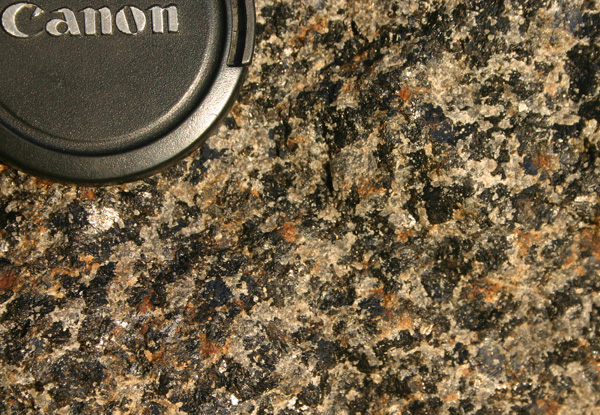
Particularly coarse phase of the mafic (basaltic) sill with plagioclase and clinopyroxene grains. Camera lens for scale.
Rhine Graben, in northern Europe.
- north of the Alps and roughly contemporaneous with crustal shortening in the Alps.
- Wikipedia article on European Cenozoic rift system (with a good map).
- also a site of some intraplate seismic risk.
Basin and Range province covering a good bit of the southwest U.S..
- AGU site. Map below is from the USGS tapestry site. The striped pattern is due to the Basin and Range province (looks like continental stretch marks?). The map to the right shows the larger extent of the Basin and Range province and is from http://geomaps.wr.usgs.gov/parks/deva/ftdan1.html . Note the overall map distribution form of the province - it is not a linear parting of the ways.
- Also site of metamorphic core complexes (more info below), a distinctive feature associated with extreme continental rifting.
Keweenawan rift and the mid-continent gravity high - in the interior of the U.S..
- Age - roughly 1.1 Ba.
- UNO field trip.
- Below is a map taken from the USGS site: http://pubs.usgs.gov/info/mwni_cu/ . where the specific interest is in possible nickel-copper deposits. Rifts can not only be the sites of ore mineralization, but can also harbor fossil fuel deposits, and so rifts are a common exploration target. This is the exposed portion of the rift.
-
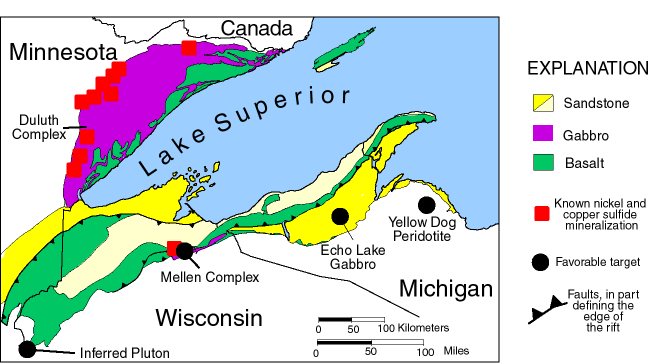
- The gravity high and rift continue in the subsurface down into Kansas and cut through the SE corner of Nebraska, where a cluster of earthquake activity is broadly associated with the rift.
Extensional accommodation mechanisms
The diagram to the right attempts show various mechanisms associated with continental extension:
- normal faulting.
- high angle normal faulting (component 1).
- low angle normal faulting (component 6).
- brittle ductile transition on site of detachment.
- common half graben geometry.
- dike swarms (component 2).
- lower crustal attenuation (component 3).
- lower crustal intrusion (component 4).
- As Lister et al. 1986 explore the specific mix and architecture of these mechanisms varies significantly.
Lithospheric thinning (5) is observed with modern rifts. What are the responsible mechanisms?
What is low angle normal faulting? You may remember from your Physical Geology or Structural Geology course that normal faults have a dip of ≈ 60° and many such faults do. However, there are also normal faults that dip at very low angles, in some cases sub-horizontal. These are often linked to normal faults with more 'standard' dips as evident in the diagram below. There was a significant debate as to the mechanics of such low-angle normal faults (e.g. Collettini 2011). Some people argued that they started out in a steeper position and then were rotated into a low-angle position, where they were inactive. However, evidence has accumulated that actively slipping low-angle normal faults occur. Understanding them mechanically involves the concept of very low strength surfaces, possibly with high fluid pressures. Extensive subhorizontal faults are known as detachments (with the upper plate detached from the underlying lower plate). A natural question to ask is what localizes the detachment at a given level?
Extensional detachments as an expression of thin-skinned tectonics: A mini-revolution within plate tectonics was realizing that detachments played an important role in the architecture of plate boundaries, both at convergent and divergent margins. This architecture of a deformed upper plate above a detachment with a less or differently deformed lower plate below was given the name of 'thin-skinned' tectonics. Detachments can have areas of 10,000s of square kilometers.When we describe convergent margins the concept of detachments and thin-skinned tectonics will be explored again.
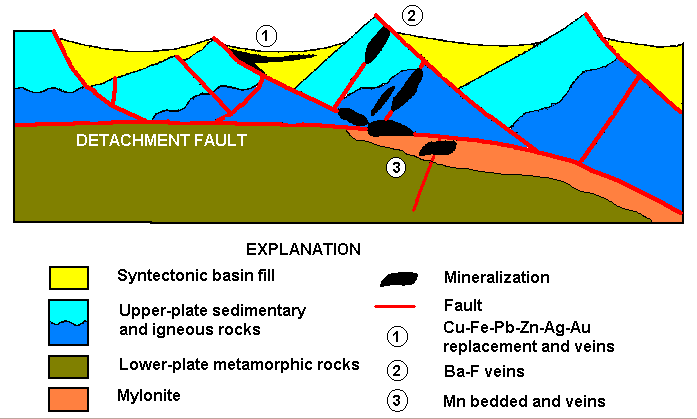
Schematic image from USGS based on Basin and Range rifting showing the subhorizontal detachment and the position of mineralization in this tectonic context. Image from https://pubs.usgs.gov/bul/b2004/html/bull2004detachmentfaultrelated_mineraliz.htm accessed 9/5/2018.
Metamorphic core complexes and lower crustal flow, associated with extreme extension, more info here.
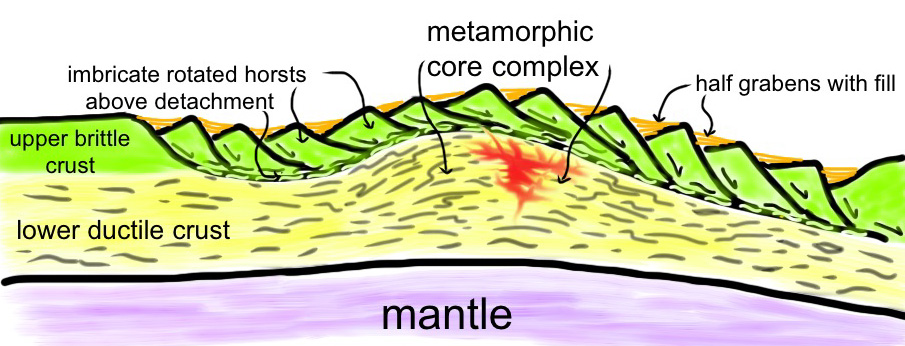
Schematic cross section sketch of a metamorphic core complex, which is a large antiformal feature where metamorphic basement is in the core, and separated from overlying, extended cover rocks and sedimentary fill by a fault zone composed of both ductile fault rocks (mylonites) and brittle fault rocks (often with brittle overprinting ductile features). There is discussion on the role of isostatic rebound and/or lower crustal ductile flow play in the development of the large elongate domal feature.
More information, diagrams and photos on the structural geology of rift zones in general, and on the Basin and Range in particular can be found at: http://maps.unomaha.edu/maher/GEOL3300/week14/rift.html .
Rift-related igneous activity
Traits:
- igneous activity occurs in association with many but not all continental rifting.
- typical bimodal compositional signature - lots of basalts and some rhyolites.
- do rifts have a distinctive trace element geochemistry.
- What are all factors that determine the chemical composition of a melt?
- continental rift basalts enriched in alkalis (K, Ba, Rb), incompatible elements, LIL.
- deep mantle plume contribution.
- mantle fluids and metasomatism.
- lithospheric mantle contribution.
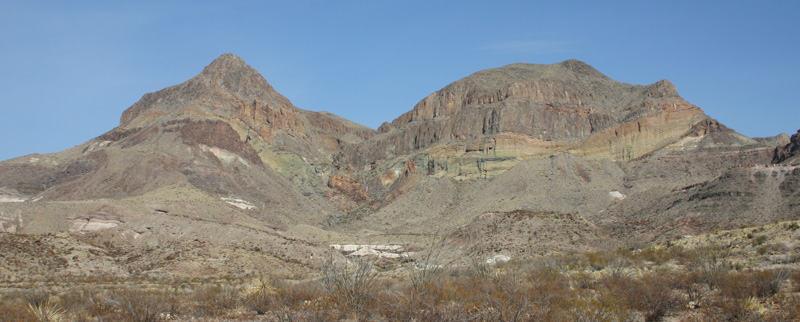
Goat Mountain in Big Bend National Park in Texas. These pyroclastics from explosive volcanism in the past are part of the Basin and Range rift basin that the National Park is centered on. These are silicic in composition and represent part of the rhyolite end of the spectrum associated with continental rifts. The area is no longer volcanically active, but was about 38-32 million years ago. The image below is from the park and shows the geologic interpretation of Goat Mountain.
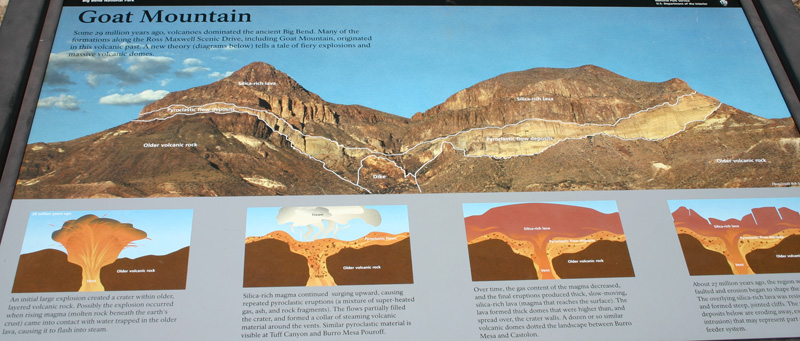
Rift basin sedimentation
Traits:
- sediment traps, accommodation space up to several miles deep.
- often immature sediments since source to sink distances are so short.
- half grabens - asymmetric, tilting, due to thin-skinned style of tectonism and associated sub-horizontal detachment.
- fault driven sedimentation: alluvial fans and debris flows (fanglomerates).
- along strike changes in fault and basin architecture produces segmentation, and separate depocenters.
- every basin unique: Carboniferous rift on Bjørnøya.
-
Below: cross section of rift sediments in the Newark Basin from the USGS. Note the relationship between the sediment type and its position in the half graben.
-
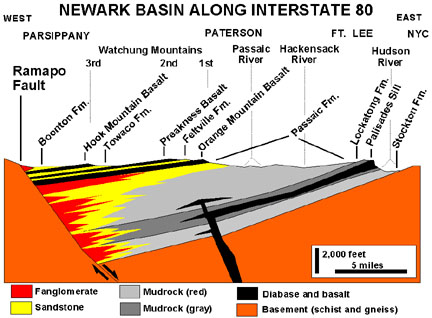
Basin analysis: holistic look at a basin and the factors that contributed to its character. What factors in particular might influence rift basins?
Death Valley is an excellent place to study the sediments being deposited in an active rift basin, and the images below show some of the relationships.

In the foreground is an alluvial fan in Death Valley (note the person to the right for scale) that consists mainly of debris flow deposits that emanate from the canyon mouth at the apex of the fan. These deposits are fanglomerates. A careful look will show a fault scarp that displaces these deposits and runs parallel to the mountain front. This is part of the rift bounding normal fault (likely with a strike-slip component) that has caused the mountain uplift. The rock basin above is the source of the debris flows that mainly happen during the rare (from a human perspective) and intense rain falls that mobilize debris flows in this part of the world.
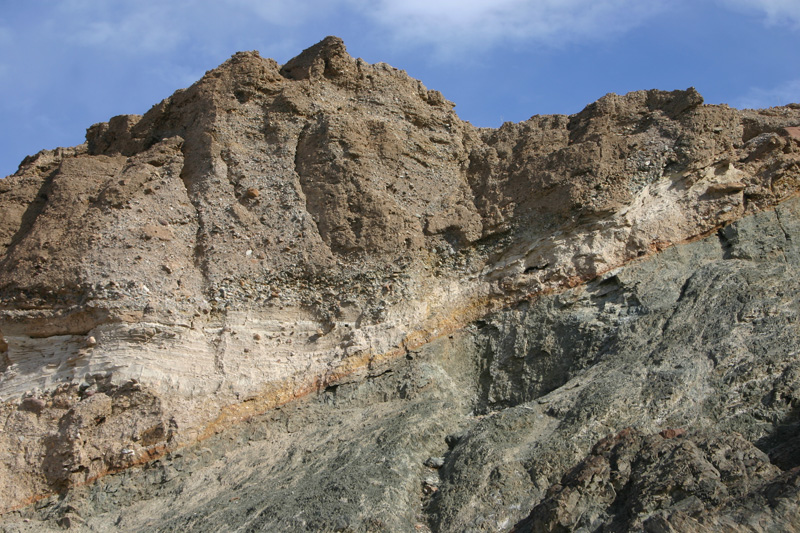
Fanglomerate and other Death Valley rift deposits faulted against mylonitized, brecciated and chloritized (from retrograde metamorphism) basement rocks. This detachment is part of a metamorphic core complex. Note the low angle orientation and low angle truncation of the hanging wall sediments against the fault.
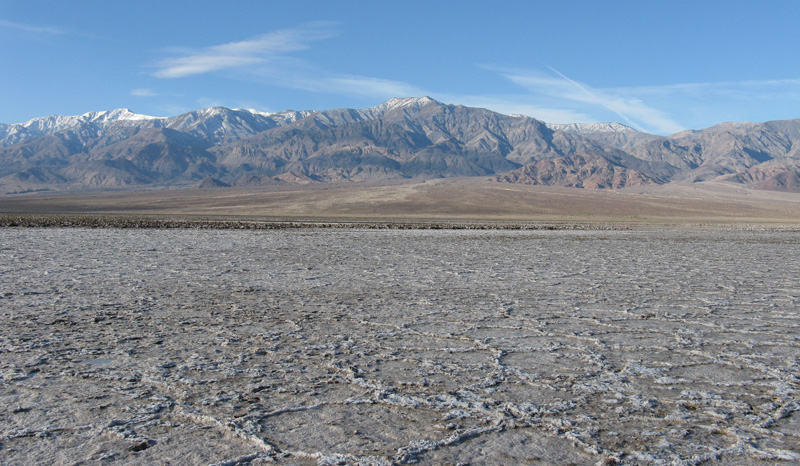
Evaporite (salt deposits) that occupy the middle part of the Death Valley rift, with alluvial fan deposits across the way on the other side.
Thermal and uplift history
Mechanisms and geometry
- higher heat flow due to advective/magmatic fluid transfer in crust.
- higher heat flow due to thinner crust and lithosphere.
- thermal and isostatic uplift components.
- off axis thermal and igneous activity, and its relationship to a thin-skinnned tectonic style.
- consider the g eothermal map below ( http://www1.eere.energy.gov/geothermal/geomap.html). Given what we have discussed so far, which areas with high heat flow in the U.S. can be attributed to ongoing or recent rifting and which to something else?
-
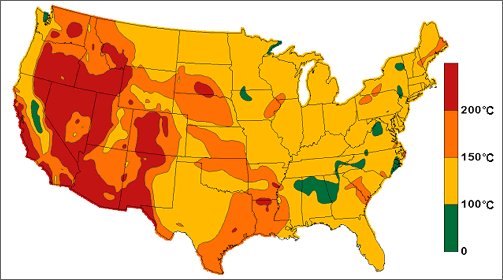
- once rifting stops, cooling and subsidence takes over, and if there is a rift fill of denser basalts this may produce even more subsidence (as exemplified by the Michigan basin which is underlain by an arm of the Keweenawan rift).
Exercise: map patterns of continental rifts: How consistent is the direction of fault map traces? How consistent is the direction of down throw? Are the faults curved or angular in map plan? Are any other map patterns discernable (en echelon, radial, triple junction)? Is segmentation spacing consistent? Frequency and pattern of branching?What might be factors that determine the pattern of continental rifting ?
Map pattern evolution and models for continental rifting
Hot spots (mantle plumes), triple junctions and aulocogens (Burke & Dewey (1973) model).
- stationary plumes -> continental doming, igneous activity and thinning and weakening of lithosphere -> development of triple junction pattern of rifts -> propagation and continued spreading and rift linkage -> domination of igneous processes over faulting and development of seafloor spreading center for some rifts, while other rifts cease activity.
- application to EAR, and south Atlantic.
- some questions:
- inadequacy of doming stresses to create rifts.
- validity of triple junction pattern (as 120 degree angle between arms), and role of previously existing crustal anisotropy.
- transition from triple junction to orthogonal seafloor spreading geometry.
- map from USGS showing a simplified the EAR rift zone:
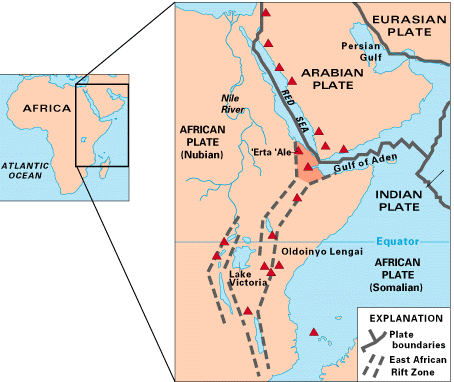
Influence of previous structure on rift patterns? One broad example of this is how the Norwegian-Greenland oceanic basin follows the axis of the Norwegian-Greenland Caledonides.
Rift tip propagation, Vink and Courtillot model:
- propagating ocean basin/crust tip with seafloor spreading behind the tip, and continental rifting ahead.
- application to Gulf of Aden and Gulf of California (key trait, slight obliquity between seafloor magnetic anomalies and continental margins)
- locked zones
- implications for fits of continental margins.
- beyond pole-of-rotation compression.
- studies in wax of rift propagation/evolution.
- passive vs. active rifting.
Orogenic topographic collapse: localized rifting within orogenic welts can be coeval and spatially related to crustal thickening in convergent settings - best example is the Himalayas.
- Ordovician-Silurian major contractional orogeny followed by:
- Devonian gravitational collapse basins.
- limited Carboniferous rifting.
- Jurassic-Cretaceous rifting.
- Tertiary formation of the oceanic basin.
- A curious episodic rifting along the Caledonide axis in this area over a course of 300 Ma.
- Has been applied to Basin and Range - collapse of subduction related Sevier crustal thickening.
Rigid indentor models .
- One needs an introduction to oroclines for a full explanation.
- Usually used in application to the Rhine graben. Link to satellite image of Alps and Rhine graben , from http://veimages.gsfc.nasa.gov/5188/France.A2003078.1050.500m.jpg.
Transtensive releasing bends : will take about much more later.
Intraplate tectonism : a possible model for Carboniferous basins on the Barents Shelf.
Some general references on continental extensional tectonics:
- Baker, B. H. & others, 1972, Geology of the Eastern Rift System of Africa; Geological Society of America Special Paper 136, 67 p. Mainly a thorough descriptive effort.
- Burke, K. & J. Dewey, 1973, Plume-generated triple junctions: Key indicators in applying plate tectonics to old rocks; Journal of Geology, vol. 81, p. 406-433. A classic in plate tectonics describing a mechanical-historical model for continental rifting with many testable aspects (developed in the context of the EAR).
- Craddock, C., 1973, Structural evolution of the Keweenawan Province; Geology, vol. 1, # 4, p. 190. Describes the history of this Precambrian intracontinental rift.
- Courtillot, V. & Vink, G. E., 1983, How continents break-up: Scientific American, p. 43-49.
- Lister, G. & others, 1986, Detachment faulting and the evolution of passive continental margins; Geology, vol. 14, p. 246-250.
Describes a variant on the Wernicke model and applies it to continental margins, discussing the effect of the inherent asymmetry of Wernicke's and their model on margin development. - Mohr, P., 1987, Structural Style of Continental Rifting in Ethiopia: Reverse decollements: EOS, p. 721, 729-730.
- Rosendahl, B. R., 1987, Architecture of continental rifts with special reference to East Africa; Annual Review of Earth and Planetary Sciences, 15, 445-503. Discusses segmentation, and the relation to deeper underlying processes.
- Ruppel, C., 1996, Extensional Processes in Continental Lithosphere; Journal of Geophysical Research, v. 100, p. 24,187-24,215. An excellent summary of continental rifting - a very good place to start, and to look for additional references.
- Scholz, C. H. & Contreras, J. C., 1998, Mechanics of continental rift architecture; Geology, v. 26, p. 967-970. Elegant paper with very testable assertions as to the 3-D geometry of rifts.
- Serpa, L. & others, 1984, Structure of the southern Keweenawan rift from COCORP surveys across the midcontinent geophysical anomaly in northeastern Kansas; Tectonics, vol. 3, # 3, 367-384. Demonstrates the listric, low-angle character of this rift.
- Illies, J. H. (ed.), 1981, Mechanism of Graben Formation - Development in Geotectonics 17; Elsevier press, New York, 226 p.
- Wernicke, B., 1981, Low-angle normal faults in the basin and range province: nappe tectonics in an extending orogen; Nature, vol. 291, p. 645-647. A crucial paper reinforcing the idea of thin-skinned extension, and applying it to the entire plate thickness.
References on the Basin and Range province:
- Allmendinger & others, 1983, Cenozoic and Mesozoic structure of the eastern Basin and Range province, Utah from COCORP seismic reflection data; Geology, v. 11, 532-536.
- Davis, G. & Lister, G., 1988, Detachment faulting in continental extension; Perspectives from the southwestern U. S. Cordillera; GSA Special Paper 218, p. 133-161.
- Gans, P. B., Mahood, G. A., & Schermer, E., 1989, Synextensional magmatism in the Basin and Range Province: A case study from the eastern Great Basin: GSA Special Paper # 233, P. 53.
- Lister, G. & Davis, G., 1989, The origin of metamorphic core complexes and detachment faults formed during Tertiary continental extension in the northern Colorado River region, U.S.A.
- Mayer, L. (ed.), 1986, Extensional Tectonics of the Southwestern United States: A perspective on Processes and Kinematics: GSA Special Paper # 208, 122 p.
- Wernicke, B., 1981, Low-angle normal faults in the Basin and Range province: Nappe tectonics in an extended orogen; Nature, v. 291, p. 645-648.
References on core complexes, gravitational collapse, extensional detachments, and sundry:
- Braathen, A., Nordgulen, Ø, Osmundsen, P. T., Anderson, T. B., Solli, A., and Roberts, D., 2000, Devonian, orogen-parallel, opposed extension in the Central Norwegian Caledonides; Geology, 28, 615-618.
- Collettini, C., 2011, The mechanical paradox of low-angle normal faults: current understanding and open questions; Tectonoohysics, 510, 253-268.
- Dewey, J.D., 1987, Extensional collapse of orogens. Tectonics, 7, 1123-1139.
- Fossen, H. & Rykkelid, E., 1992, Postcollisional extension of the Caledonide orogen in Scandinavia: structural expressions and tectonic significance; Geology, 20, 737-740.
- Godin, L., Grujic, D., Law, R. D. and Searle, M. P., 2006, Channel flow, ductile extrusion and exhumation in continental collisoin zones: an introduction: in Law, R. D.., Searle, M. P., and L. Godin (eds.), Channel flow, ductile extrusion and Exhumation in Continental Collision Zones; Geol. Soc. London Special Publicaiton 268, p. 1-23.
Course materials for Plate Tectonics, GEOL 3700, University of Nebraska at Omaha. Instructor: H. D. Maher Jr., copyright. This material may be used for non-profit educational purposes with appropriate attribution of authorship. Otherwise please contact author.
Source: https://maps.unomaha.community/Maher/plate/week3/contrift.html
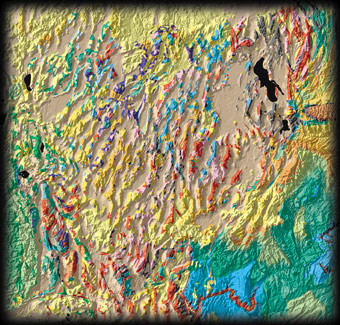

0 Response to "If Rifting Continues the Continent Will Remain Intact"
Post a Comment